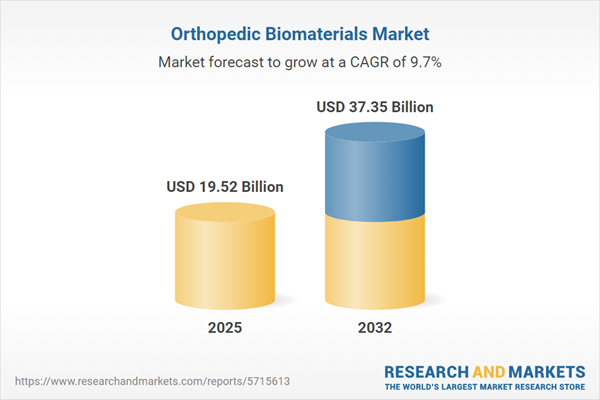Speak directly to the analyst to clarify any post sales queries you may have.
The orthopedic biomaterials market presents senior leaders with evolving opportunities for innovation and strategic growth as industry priorities shift rapidly alongside scientific and clinical advancements. Organizations that proactively adapt to new requirements can realize improved patient outcomes and operational efficiencies.
Market Snapshot: Orthopedic Biomaterials Market Size and Growth
In 2024–2025, the orthopedic biomaterials market grew from USD 17.79 billion to USD 19.52 billion and is projected to reach USD 37.35 billion by 2032, signifying a compound annual growth rate of 9.71%. Expansion is primarily fueled by aging populations, increasing rates of musculoskeletal conditions, and wider access to advanced orthopedic procedures globally. Regulatory changes and evolving care protocols are also prompting strategic investments and continuous adaptation from industry providers seeking consistent improvements in service quality and patient care experiences.
Scope & Segmentation of the Orthopedic Biomaterials Market
- Material Types: Ceramics such as alumina and hydroxyapatite, valued for supporting bone integration and biological compatibility, combine with metals including cobalt chrome, titanium alloys, and stainless steel to deliver durability and mechanical strength. Composite materials like carbon and glass fiber support progressive recovery models, while advanced polymers such as PEEK and ultra-high molecular weight polyethylene enable application flexibility and tailored patient solutions.
- Application Verticals: This market underpins a broad range of procedures from dental bone grafts, trauma fixation, and joint replacements to spinal fusion and sports injury interventions. Demand for these applications spans general, specialized, and rehabilitation care, supporting care continuity across various therapeutic environments.
- End User Categories: Hospitals, ambulatory surgical centers, specialized orthopedic clinics, and research organizations prioritize adopting the latest biomaterial innovations to align with shifting patient expectations, clinical research findings, and growing operational complexity.
- Technological Innovations: Additive manufacturing enables patient-specific implant creation for precise anatomical fit, while nanotechnology supports targeted and controlled delivery of treatments. Cell-based therapies and bioactive scaffolds hold potential for improved healing processes and greater consistency in clinical outcomes.
- Geographic Segmentation: The Americas, Europe, Middle East and Africa, and Asia-Pacific regions each possess distinct health infrastructure, compliance considerations, and market access factors. Regional differentiation is critical, requiring tailored procurement strategies and adaptable technology adoption to match local regulatory environments and supply chain capabilities.
Key Takeaways for Senior Leaders
- Implementing personalized biomaterial approaches equips clinical teams to address diverse patient needs and rehabilitation pathways with agility and responsiveness.
- Strategic investment in digital manufacturing and nanotechnology strengthens adaptability to frequent updates in clinical practice standards and enhances orthopedic innovation.
- Integrating cell-based therapies and bioactive scaffolds fosters improved healing rates and supports consistent, measurable patient outcomes across multiple settings.
- Collaborating with manufacturers and research organizations accelerates the uptake of emerging scientific advances, shortening the time from innovation to standard practice.
- Optimizing procurement and digitizing supply chain processes strengthens regulatory compliance and improves resilience to external shifts that impact operations or market conditions.
- Ongoing process optimization and adoption of innovative technologies contribute to sustained competitive advantage in a rapidly evolving industry.
Tariff Impact and Strategic Response
Forthcoming U.S. tariffs on selected orthopedic biomaterial imports, effective in 2025, have accelerated supplier moves toward regional partnership models and new sourcing strategies. Local procurement activities, while potentially challenging short-term profitability, are enhancing responsiveness and control within dynamic market environments. Organizations prioritizing agile logistics and regional adaptability are better positioned to manage regulatory shifts and maintain steady supply chains during trade fluctuations.
Methodology & Data Sources
Findings in this report draw from comprehensive expert interviews, structured reviews of regulatory and intellectual property documentation, and robust quantitative modeling. Each insight is validated through careful cross-verification of data to ensure high analytical rigor and reliability for senior business decisions.
Why This Report Matters to Decision-Makers
- Delivers actionable intelligence to guide leadership teams in understanding market structure and strategic drivers, supporting proactive planning and risk assessment.
- Presents detailed segmentation and regional analysis, offering clear guidance for resource allocation and efficient navigation of variable compliance obligations.
- Offers recommendations grounded in evidence to refine procurement, stimulate technological innovation, and enhance organizational responsiveness to industry developments.
Conclusion
This report provides senior executives with focused insights for advancing organizational resilience, capitalizing on growth prospects, and strengthening positioning as the orthopedic biomaterials industry evolves.
Additional Product Information:
- Purchase of this report includes 1 year online access with quarterly updates.
- This report can be updated on request. Please contact our Customer Experience team using the Ask a Question widget on our website.
Table of Contents
3. Executive Summary
4. Market Overview
7. Cumulative Impact of Artificial Intelligence 2025
Companies Mentioned
The companies profiled in this Orthopedic Biomaterials market report include:- Johnson & Johnson
- Stryker Corporation
- Zimmer Biomet Holdings, Inc.
- Smith & Nephew plc
- Medtronic plc
- NuVasive, Inc.
- Globus Medical, Inc.
- Orthofix Medical Inc.
- SeaSpine Holdings Corporation
- Anika Therapeutics, Inc.
Table Information
| Report Attribute | Details |
|---|---|
| No. of Pages | 196 |
| Published | October 2025 |
| Forecast Period | 2025 - 2032 |
| Estimated Market Value ( USD | $ 19.52 Billion |
| Forecasted Market Value ( USD | $ 37.35 Billion |
| Compound Annual Growth Rate | 9.7% |
| Regions Covered | Global |
| No. of Companies Mentioned | 11 |









